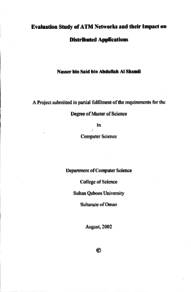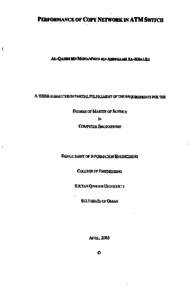Document
Evaluation Study of ATM Networks and their Impact on Distributed Applications
Publisher
Sultan Qaboos University
Gregorian
2002
Language
English
English abstract
The new emerging technologies such as distributed web applications, video and audio on demand, video conferencing and internet technology are putting a tremendous strain on the networking infrastructure. Recent research efforts have addressed performance analysis of ATM networks from the pure low-level communication aspects without relating it to real applications. Distributed applications running over high-speed network architecture, introduce a number of performance factors that are not considered in the low-level communication models. Examples of such factors include database query distribution, query sizes, serving the queries, replies delays. The estimation of the response time is an important parameter in the performance study of a system. Another example is estimating the saturation level in the system. That is estimating the maximum request generation rate or the maximum number of clients in the system. Also it is helpful in studying the effectiveness of changing some parameters in the system. This study proposes an analytical model that captures the effect of ATM network on distributed client-server applications in terms of response time. The response time has several components such as propagation delay, processing delay and queuing delay. The proposed model of an ATM LAN identifies the queuing delay that exists in a distributed applications. First the system is divided into sub-systems and we model each sub-system individually then an aggregation of all the sub-systems lead to an overall model for the system. The idea of division in sub-models is very useful for bottlenecks' detection in the system. Furthermore, an appropriate Colored Petri Net models are developed and used for simulation and validation of the analytical results. The results obtained by the simulation were in close agreements with the analytical results
Description
Thesis
Member of
Resource URL
Arabic abstract
الموزعة إن انبثاق التقنيات الحديثة مثل تطبيقات الشبكة الموزعة والفيديو والصوت وتقنية المؤتمرات بواسطة الفيديو وتقنيات الإنترنت يولد ضغوط على البنية التحتية للشبكة. توجهت الأبحاث الحديثة لأداء شبكةATM إلى المستوى الأدنى للاتصالات من غير ربطه بالتطبيقات الواقعية. التطبيقات الموزعة التي تعمل على شبكات عالية السرعة كشفت عن عدة عوامل التي لم تؤخذ بالاعتبار في نماذج الاتصالات ذات المستوى الأدنى. بعض الأمثلة لهذه العوامل يتضمن كيفية توزيع استعلامات في قاعدة البيانات من حيث حجمها وزمن خدمتها وأيضا زمن وصول الإجابة عليها. يعتبر تقدير وقت الاستجابة عامل مهم في دراسة تقييم مستوى أداء الأنظمة. مثال آخر هو تقدير مستوى الإشباع في النظام أي بمعنى تقدير أقصى معدل إصدار للاستعلامات و تقدير العدد الأقصى لمستضيفي النظام. هذه الدراسة تعرض نموذج تحليلي يغطي تأثير شبكة ATM على تطبيقات المستضاف والملقم ( Client / Server ) من ناحية وقت الاستجابة. إن لوقت الاستجابة عدة مكونات من بينها تأخير التنقل وتأخير المعالجة وكذلك تأخير وقت الاصطفاف. النموذج المقترح للشبكة المدروسة يحدد تأخير المعالجة و وقت الاصطفاف الناتج مع التطبيقات الموزعة. في البداية يتم تقسيم النظام إلى أنظمة جزئية وكل نظام جزئي يتم اشتقاق نموذج تحليلي له بشكل فردي. بعد ذلك تدمج هذه النماذج الجزئية للحصول على نموذج تحليلي شامل بحيث يغطي جميع أجزاء النظام. إضافة لذلك يتم إنشاء شبكات باستخدام برامج المحاكاة وذلك لغرض دعم والتأكد من النتائج التحليلية. لقد كانت النتائج قريبة من نتائج النموذج التحليلي مما يؤكد صحة النموذج التحليلي
Category
Theses and Dissertations


